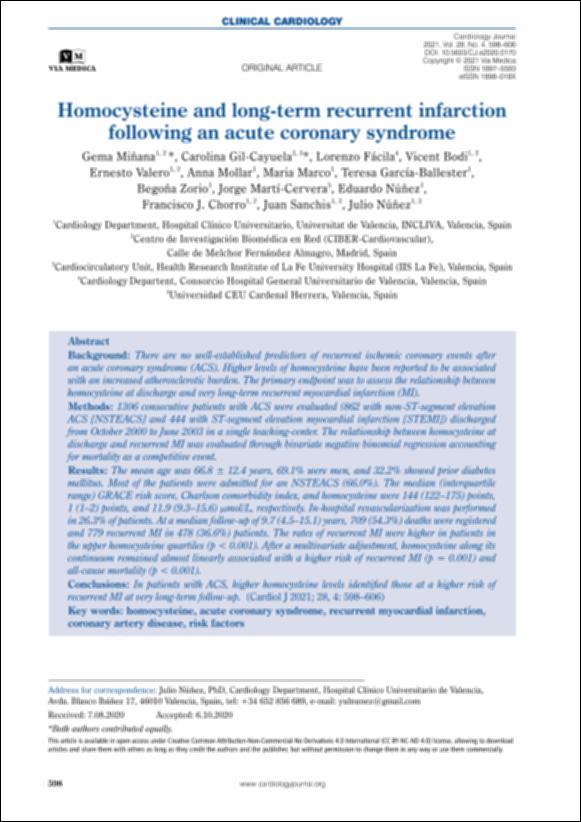Por favor, use este identificador para citar o enlazar este ítem:
http://hdl.handle.net/10637/13612Homocysteine and long-term recurrent infarction following an acute coronary syndrome
| Título : | Homocysteine and long-term recurrent infarction following an acute coronary syndrome |
| Autor : | Miñana Escriva, Gema Gil Cayuela, Carolina Fácila Rubio, Lorenzo Bodi, Vicent Valero Picher, Ernesto Mollar Fernández, Anna Martí Cervera, Jorge |
| Materias: | Cardiovascular system - Diseases - Risk factors.; Infarto de miocardio - Factores de riesgo.; Coronary heart disease - Risk factors.; Enfermedades cardiovasculares - Factores de riesgo.; Enfermedad coronaria - Factores de riesgo.; Myocardial infarction - Risk factors. |
| Editorial : | Via Medica. |
| Citación : | Miñana, G., Gil-Cayuela, C., Fácila, L., Bodi, V., Valero, E., Mollar, A. et al. (2021). Homocysteine and long-term recurrent infarction following an acute coronary syndrome. Cardiology Journal, vol. 28, i. 4 (01 jul.), pp. 598–606. DOI: https://doi.org/10.5603/CJ.a2020.0170 |
| Resumen : | Background: There are no well-established predictors of recurrent ischemic coronary events after an acute coronary syndrome (ACS). Higher levels of homocysteine have been reported to be associated with an increased atherosclerotic burden. The primary endpoint was to assess the relationship between homocysteine at discharge and very long-term recurrent myocardial infarction (MI). Methods: 1306 consecutive patients with ACS were evaluated (862 with non-ST-segment elevation ACS [NSTEACS] and 444 with ST-segment elevation myocardial infarction [STEMI]) discharged from October 2000 to June 2003 in a single teaching-center. The relationship between homocysteine at discharge and recurrent MI was evaluated through bivariate negative binomial regression accounting for mortality as a competitive event. Results: The mean age was 66.8 ± 12.4 years, 69.1% were men, and 32.2% showed prior diabetes mellitus. Most of the patients were admitted for an NSTEACS (66.0%). The median (interquartile range) GRACE risk score, Charlson comorbidity index, and homocysteine were 144 (122–175) points, 1 (1–2) points, and 11.9 (9.3–15.6) μmol/L, respectively. In-hospital revascularization was performed in 26.3% of patients. At a median follow-up of 9.7 (4.5–15.1) years, 709 (54.3%) deaths were registered and 779 recurrent MI in 478 (36.6%) patients. The rates of recurrent MI were higher in patients in the upper homocysteine quartiles (p < 0.001). After a multivariate adjustment, homocysteine along its continuum remained almost linearly associated with a higher risk of recurrent MI (p = 0.001) and all-cause mortality (p < 0.001). Conclusions: In patients with ACS, higher homocysteine levels identified those at a higher risk of recurrent MI at very long-term follow-up. |
| Descripción : | En Cardiology Journal. Gdańsk (Polonia) : Via Medica. Vol. 28, n. 4 (01 jul. 2021), pp. 598-606. ISSN 1897-5593. e-ISSN 1898-018X. Este artículo se encuentra disponible en la siguiente URL: https://journals.viamedica.pl/cardiology_journal/article/view/CJ.a2020.0170/52602 En este artículo de investigación también participan: Maria Marco, Teresa García-Ballester, Begoña Zorio, Eduardo Núñez, Francisco J. Chorro, Juan Sanchis y Julio Núñez. |
| URI : | http://hdl.handle.net/10637/13612 |
| Derechos: | http://creativecommons.org/licenses/by-nc-nd/4.0/deed.es |
| ISSN : | 1897-5593 1898-018X (Electrónico) |
| Fecha de publicación : | 1-jul-2021 |
| Aparece en las colecciones: | Dpto. Medicina y Cirugía |
Los ítems de DSpace están protegidos por copyright, con todos los derechos reservados, a menos que se indique lo contrario.


